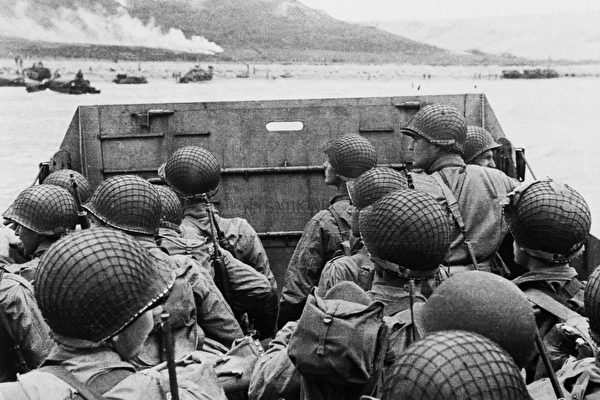On June 6, 1944, 80 years ago, the Allied forces led by the United States crossed the English Channel and landed on the beaches of Normandy, France, officially launching a major counterattack against Nazi Germany. The Allies had prepared a force of 1 million soldiers, with 156,000 successfully storming ashore at five different landing points. If there were a conflict in the Taiwan Strait today, the Chinese Communist Party (CCP) would not be able to conduct a landing operation like the one at Normandy 80 years ago.
On the day of the Normandy Landings, the Allies deployed 156,000 infantry troops to carry out the assault, supported by approximately 196,000 naval personnel.
The German defenders at Normandy numbered around 50,000, with the direct attack force ratio at 3:1 in favor of the Allies. Despite suffering over 10,000 casualties, the Allies successfully landed at all five locations.
The Allies compared four potential landing sites before choosing Normandy. While Calais in France was the closest to England, it was heavily defended by the Nazis and presented geographical challenges. Normandy, although farther, offered expansive beaches that allowed for inland advancement. However, the lack of port facilities at Normandy required the Allies to make modifications for large-scale landing of heavy equipment and follow-up forces.
The Allied ground forces gathered in ports like Plymouth, UK, totaling 39 divisions, including 22 American, 12 British, 3 Canadian, 1 Polish, and 1 French division, with a total force exceeding 1 million soldiers.
The CCP has been planning an attack on Taiwan, but on the first day, it would struggle to transport 150,000 soldiers to Taiwan. Taiwan currently has an active military force of 247,000 personnel, with around 2.31 million reserves.
With 975,000 active troops in the CCP’s army, even if half were deployed, they would not achieve a 3:1 advantage. Taiwan lacks broad beaches like Normandy for landing operations, limiting the CCP’s amphibious capabilities. The current landing vessels of the CCP can only transport around 20,000 personnel at a time, and the lack of suitable landing points in the Taiwan Strait hinders reinforcement support.
During the Normandy Landings, the Allies deployed a total of 6,939 ships, including 1,213 warships, 4,126 landing crafts, 736 auxiliary vessels, and 864 merchant ships. The main vessels capable of ground attacks included 6 battleships, 22 cruisers, and 65 destroyers.
If the CCP were to invade Taiwan, it could potentially gather thousands of civilian ships, but the quantity of warships pales in comparison to the scale of the Allied forces during the Normandy Landings. The CCP’s navy currently includes 8 Type 055 destroyers, 25 Type 052D destroyers, with limited ground-to-ground missile capabilities. The CCP’s destroyer fleet lacks sufficient numbers to engage in Taiwan Strait combat effectively and remains within the range of Taiwanese anti-ship missiles.
The CCP has around 40 Type 054A frigates, but they are only equipped with small-caliber guns and lack ground-to-ground missile capabilities. While the CCP could mobilize a significant number of civilian ships, their deployment range would likely be twice that of the Normandy Landings. The CCP’s naval firepower is limited and unable to match the effectiveness of the artillery used during the Normandy Landings.
The Normandy Landings was the largest amphibious operation in history, with the first day achieving success with fewer casualties than expected. However, the overall operation did not meet all its planned objectives promptly.
According to the Allies’ plans, the first day of landing aimed to swiftly secure beachheads and capture nearby towns like Carentan, St. Lo, Caen, and Bayeux. While Allied forces successfully stormed the beaches, their advancement fell short of the planned frontline attack points by 10 to 16 kilometers.
It took six days, until June 12, for the five beachheads to connect, forming a 97-kilometer front extending 24 kilometers deep. However, the Allies did not capture the nearby town of Caen until July 21. The CCP’s claims of swift victory in an invasion lack feasibility in reality.
The surprise element was crucial in the Normandy Landings, catching the German defenses off guard. The extended coastline posed challenges for the efficient deployment of German forces and resources.
Pauses were commonplace due to weather and sea conditions during the Normandy Landings, which were feasible only in June. In a potential conflict in the Taiwan Strait, the CCP would have limited options in April and October, and their military readiness cannot be easily concealed, making maneuvers around Kinmen and Matsu difficult.
Eighty years after the Normandy Landings, there are valuable lessons for potential conflict in the Taiwan Strait today. The CCP lacks many landing prerequisites, and faces a significantly stronger defense force. The CCP’s main concern remains the U.S. military, and trying to outmaneuver the most experienced landing forces of the U.S. would be a miscalculation.
The Normandy Landings also included a massive airborne operation which, though costly in casualties, achieved strategic objectives. The CCP lacks the necessary transport aircraft numbers and cannot replicate the same, unable to evade air defense systems.
The Normandy Landings on June 6 remains a pivotal reference point for the potential conflict in the Taiwan Strait today. The CCP’s military lacks crucial landing conditions and faces a formidable defense force. The CCP’s attempt to challenge the most experienced U.S. landing forces may prove to be an ill-advised decision.

